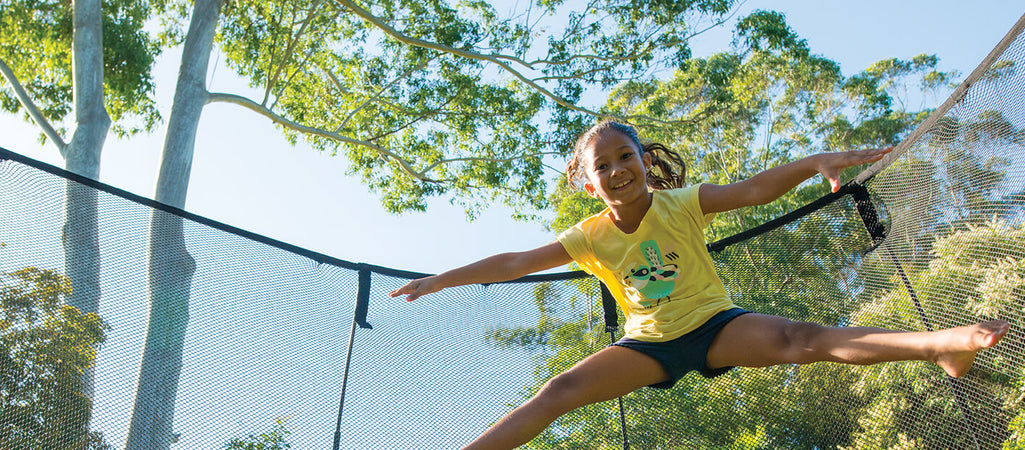What Is Unstructured Play? (Benefits + Examples)
Unstructured play: What is it, and why does it matter? Learn the benefits and get inspired with real-life examples. This is your expert guide on fostering free play.
min read

Unstructured play is essential to a child’s growth in all areas of life.
In a world filled with screens, this type of free, unorganized play has never been more important.
But there are a lot of questions about unstructured play, like:
- What is it?
- Why is it important and what are the benefits?
- How does it compare to structured play?
- What are the best examples of unstructured play?
As a company that created the world’s safest trampolines, we know a thing or two about unstructured play and its benefits.
We will answer the main questions about unstructured play in this wide-ranging blog filled with insights and ideas.
What Is Unstructured Play for Kids?
Unstructured play is defined by the American Psychological Association (APA) as “play that isn’t organized or directed by adults or older peers and that generally doesn’t have a defined purpose or outcome.”
We will dive more into examples later but think of classic childhood games like hide-and-seek and hopscotch to picture what unstructured play looks like.
This differs from structured play --let’s cover these differences in more detail.

Springfree Trampoline.
Unstructured Play vs. Structured Play
Structured play involves guidance from an adult and usually has a set goal in mind.
Examples of structured play include doing a puzzle or competing in team sports.
Structured play has multiple benefits for children, including:
- Increasing problem-solving abilities.
- Helping children increase their focus and attention skills.
- Understanding the importance of following rules.
- Improving social and communication skills with others.
- Learning the importance of patience when completing tasks.

Photo courtesy of Raising Children Network.
The skills you learn in a structured setting differ from those you gain in an unstructured setting (although some will apply to both).
You’ll learn more in the Benefits of Unstructured Play section, but unstructured free play taps further into the creative and imaginative part of the brain.
Both structured and unstructured play time have their purpose.
According to the National Association for Sport and Physical Education, toddlers should accumulate 30 minutes of structured physical activity per day.
Preschoolers should accumulate at least an hour of structured physical activity per day.
Although we will use this blog to discuss unstructured play, structured play is equally important when planning your child’s playtime.
Both are crucial for a child’s cognitive, physical, social and emotional development.

Photo courtesy of @ourjoyoflearning from Facebook.
Why Is Unstructured Play Important?
According to Outward Bound, American children spend 5-8 hours in front of a screen and only 4-7 minutes per day in unstructured outdoor play.
This statistic underlies the importance of unstructured play.
In the current age of technology, children are around screens more than ever.
Being around screens too much can hinder a child’s development.
According to a 2023 analysis published by the National Institutes of Health, “studies have shown that excessive screen time and media multitasking can negatively affect executive functioning, sensorimotor development, and academic outcomes.”
Without creative and active play, children miss out on the fundamental aspects of being a child.
With this can come damaging consequences.
What Are the Advantages of Unstructured Play?
Unstructured play comes with many benefits including:
- Taps into creative skills to find what interests your child.
- Allows children to use their senses and experience their emotions freely.
- Develops innovative thinking skills.
- Establishes independence for the child to make their own decisions.
- Helps children learn to calculate risks.

Springfree Trampoline.
Besides the advancement in cognitive and creative development, there can be many physical advantages to unstructured play.
Let’s take a look at examples in the next section.
Best Examples of Unstructured Play to Keep Kids Engaged
According to the National Association for Sport and Physical Education, toddlers and preschoolers should engage in at least an hour (and up to several hours) of unstructured physical activity per day.
How do you accomplish at least an hour of unstructured free play every day, though?
There are many examples of unstructured play. The goal will be to find which one your child gravitates to the most.
Here are some ideas to get you started. These can also work great for the whole family.

Springfree Trampoline.
- Playing tag with friends.
- Creating imaginary worlds with action figures or dolls.
- Riding a bike.
- Swinging on a swing set.

Photo courtesy of gobaplay.
- Playing in nature with sand, water or mud.
- Drawing without instructions.
- Climbing on a climbing structure.

Photo courtesy of gobaplay.
- Playing a musical instrument without instructions.
- Dressing in costumes and acting out stories.
We are particularly strong advocates of unstructured outdoor play.
Not only do children benefit from the play aspect, but being outdoors comes with numerous benefits.
A child who is active, outdoors and given the ability to think freely will experience the strongest benefits from unstructured play.
Is a Trampoline Right for Your Child’s Unstructured Play?
In the previous section, we mentioned trampoline jumping as an unstructured play activity.
Your first instinct as a parent when you hear “trampoline” might be to look away.
We get it. Many automatically associate trampolines with danger.
While it’s true that injuries can occur on trampolines, these can be mitigated or eliminated completely if you:
1. Buy a high-quality trampoline.
2. Follow safe jumping rules.
If you accomplish those two objectives, you will reap the benefits of bouncing – which are immense. They include:
- Improved heart health and cardiovascular system.
- Low-impact and easy on your joints.
- Excellent for developing balance and coordination.
- Great for weight management goals.
- Boon for your mental health (trampoline jumping is fun after all).
Even more, trampolines can be used not only for your kids’ unstructured play objectives but also for your fitness goals. Adults deserve to have fun too!
Check out the Five Profound Health Benefits of Trampoline Jumping to learn more about how a trampoline can help your child’s unstructured play goals.

